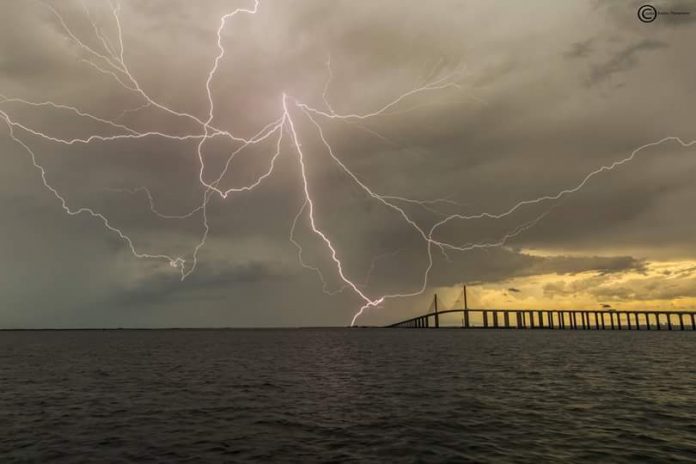As Tropical Storm Emily made landfall in the Tampa Bay region early in the week, good fishing returned very quickly at the Sunshine Skyway Fishing Piers. The best sign of a quick fishery recovery at the piers was the almost immediate reappearance of both baitfish schools and Spanish mackerel. Jack crevalle were especially good this past week and larger fish were taken than have been seen in many seasons. Mangrove snapper continue as the main nighttime attraction and these fish are less susceptible to an influx of freshwater because they spend much of their youth in brackish estuaries like coastal rivers. Sharks continue to be strong and a good mixture of both light tackle & big game adversaries remained. Tarpon seem to be making a gradual – yet steady – return to the piers as scientists believe these fish go offshore to spawn in summer and then return to favored habitats like Tampa Bay.
Perhaps the first question many avid pier anglers ask following a storm is was the salinity impacted enough by the rains to chase away pelagic species like Spanish mackerel? Often the most important signals to look for at the piers following any period of high winds & heavy rains is the return of common baitfish schools like scaled sardines and threadfin herring. These baitfish are selective about water clarity & salinity and will thus vacate an area of conditions are not suitable. When they are around, however, plenty of fish that prefer to consume these tasty morsels will also be in the region. Jack crevalle were perhaps the first to show after the storm this past week, perhaps also showing the affinity & adaptability of this species for various marine conditions. Spanish mackerel were a close second, however, and were maybe only limited by water clarity because of the manner in which they hunt.
Artificial lures remained as the top billing for mackerel catches as far as numbers this past week, but natural baits began to take a more prominent role in catches of larger mackerel. Based upon reports from seasoned mackerel anglers it was clear that artificial lures caught more fish this past week, but that natural baits produced more fish for the cooler. Silver spoons, Gotcha lures and various jigs produced lots of mackerel this past week, but many of these fish were either below or close to the legal length required for harvest. Anglers fishing live scaled sardines free-lined or underneath a float also performed very well with these just-legal smaller fish. The difference-maker in larger mackerel catches this past week came from large & slender back or belly cuts of threadfin herring deployed on a long shank hook with a long leader behind a float. When properly hooked just at the tip of the back or belly, cut strip baits like these will not only flutter slowly in the tide, but also emit a scent that will draw both predators and bait to the same area. There are times – often when water clarity or salinity is not ideal for mackerel – that this simple approach is the most effective.
Mangrove snapper continued as the hottest night bite at the piers and water conditions seem to impact this species on a much lower level than mackerel. As a result, during the Summer months mangos can be had at the piers even in tougher fishing conditions. Snapper can tolerate lower salinity and feed in cloudier waters because much of their infancy is spent amongst the mangrove shorelines & harbors of coastal rivers. There are a few tricks, however, that can lead to better snapper connections when fishing conditons are less than ideal…
Scaled sardines are usually one the of the best cut baits for snapper because their firm texture keeps the bait chunk on the hook through multiple bites. Threadfin herring get the bites, but their softer texture (due to the high oil content of the flesh) usually has anglers preferring sardines. The exception might be lower clarity water conditions – exactly as those found after a storm – because the scent emitted by the oilier flesh of the herring allows the fish to find the bait. Try black nickel circle hooks in the 1/0 to 2/0 range and the least weight available with this presentation. Use a rod with a giving tip and let the fish load-up before reeling. It might sound more like freshwater catfishing at this point, but plenty of mango limits are taken in cloudy waters at the piers each year using these tips.
Sharks continued at the hottest fish to pursue for visitors to the Sunshine State and many fish covering all size-ranges were produced. Perhaps the most popular approach at the piers for less-experienced marine anglers is to fish a cut chunk bait on medium-heavy freshwater casting or spinning tackle with about a foot of light wire leader material. This method could not be any easier and fresh bait is simply procured by fishing small bits of squid or shrimp on small gold hooks or sabiki-style baitfish rigs near the chosen location. Set out a number of rods with the tidal pull and using no weight unless the bait rises all the way to the surface. Place the drag or clicker quite light and open the bail or press the release when a strike occurs. Tighten up the drag and set on the fish after a short run and hook-ups (outside of tarpon) will be at a very high percentage. Anglers who like the monster hunting after dark with big cow nose rays, ladyfish or bonito landed several notable fish in recent days. Pictures of both a lemon & hammerhead shark in the 7 foot range were shown this past week and both fish were released to fight once again.
- The Skyway, Paul Bristow - August 24, 2018
- The Skyway, Paul Bristow - August 17, 2018
- The Skyway, Paul Bristow - August 10, 2018











